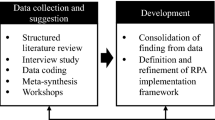
Overview
- Shows you how to implement a successful robotic process automation program in any industry
- Provides reference templates for each phase of the project and discusses how to adapt them for your organization
- Teaches the questions you need to ask to determine whether a process is a candidate for automation
Buy print copy
About this book
Introducing Robotic Process Automation to Your Organization is structured to enable you, a novice to RPA, to successfully implement an RPA program at your company. RPA is rapidly growing in use, but is only starting to be taught at a university level. Many mid-level managers will be tasked with introducing an RPA program at their organizations as senior management learns of its efficacy, but will be unfamiliar with how to do so. This book provides you with the skills and information you need to make an informed decision.
For decades, there has been much discussion about the fast pace of technology, the rapidly changing technology environment, and the need for companies to be on the cutting edge to remain competitive or even relevant. In this ever-changing environment, there is a need to know what can be done in terms of current processes, here and now, that will increase efficiency, benefit customers, and improve profitability. One option is RPA.
This book includes information to assist you in getting the required buy-in and identifying the first few processes for automation. A structure for identifying opportunities on an ongoing basis is detailed, along with concepts that must be considered for solution design and deployment. Throughout the book there are several "pause and consider" statements to help you think about how principles pertain to your organization. Additionally, there are tips included that offer short, concrete suggestions on how to help implement the particular step being discussed.
What You Will Learn
- Know the benefits of robotic process automation (RPA)
- Understand the limitations of RPA
- Ask the right questions to determine whether a process is a good candidate for automation
- Obtain buy-in from skeptics at the senior and middle manager levels, and from line workers
- Be familiar with the structure required for success
Who This Book is For
Middle managers who have either identified the need for robotic process automation (RPA) in their organization or have been directed by senior management to explore the possibility of introducing RPA to their organization; managers at all levels who hear about RPA, either through conferences, professional associations, or industry publications, and want to know more; students of business and technology who wish to broaden their understanding of important current trends.
Similar content being viewed by others
Keywords
Table of contents (12 chapters)
-
Front Matter
-
Back Matter
Authors and Affiliations
About the authors
Kamal Goyal has been working exclusively in the field of RPA for the last six years. He has been instrumental in establishing the required infrastructure at several companies, including where he currently works. He, too, is constantly learning to keep abreast of current trends within IT.
Robert Fantina is an acknowledged process improvement expert, and has worked closely with Andriy and Kamal in establishing an effective and successful RPA program at his most recent place of employment. He is the author of eight books, including Practical Software Process Improvement and Your Customers’ Perception of Quality: What It Means to Your Bottom Line and How to Control It (co-author Baboo Kureemun). His paper, "Successful Software Process Implementation", was published in the journal, Software Quality Professional. He has given presentations on process improvement and quality at conferences in Atlanta, Georgia and Los Angeles, California and Orlando, Florida, among other places.
Andriy, Kamal, and Robert have, combined, over 70 years of experience in various aspects of information technology.
Bibliographic Information
Book Title: Introducing Robotic Process Automation to Your Organization
Book Subtitle: A Guide for Business Leaders
Authors: Robert Fantina, Andriy Storozhuk, Kamal Goyal
DOI: https://doi.org/10.1007/978-1-4842-7416-3
Publisher: Apress Berkeley, CA
eBook Packages: Professional and Applied Computing, Apress Access Books, Professional and Applied Computing (R0)
Copyright Information: Robert Fantina, Andriy Storozhuk, Kamal Goyal 2022
Softcover ISBN: 978-1-4842-7415-6Published: 17 November 2021
eBook ISBN: 978-1-4842-7416-3Published: 16 November 2021
Edition Number: 1
Number of Pages: XII, 204
Number of Illustrations: 15 b/w illustrations
Topics: Robotics, Artificial Intelligence, Logic in AI, Business and Management, general, Business Strategy/Leadership, Management



